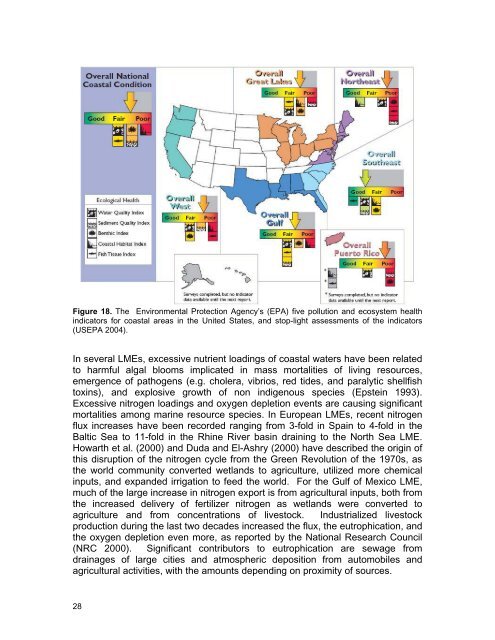Sustaining the World's Large Marine Ecosystems
Sustaining the World's Large Marine Ecosystems
Sustaining the World's Large Marine Ecosystems
You also want an ePaper? Increase the reach of your titles
YUMPU automatically turns print PDFs into web optimized ePapers that Google loves.
Figure 18. The Environmental Protection Agency’s (EPA) five pollution and ecosystem health<br />
indicators for coastal areas in <strong>the</strong> United States, and stop-light assessments of <strong>the</strong> indicators<br />
(USEPA 2004).<br />
In several LMEs, excessive nutrient loadings of coastal waters have been related<br />
to harmful algal blooms implicated in mass mortalities of living resources,<br />
emergence of pathogens (e.g. cholera, vibrios, red tides, and paralytic shellfish<br />
toxins), and explosive growth of non indigenous species (Epstein 1993).<br />
Excessive nitrogen loadings and oxygen depletion events are causing significant<br />
mortalities among marine resource species. In European LMEs, recent nitrogen<br />
flux increases have been recorded ranging from 3-fold in Spain to 4-fold in <strong>the</strong><br />
Baltic Sea to 11-fold in <strong>the</strong> Rhine River basin draining to <strong>the</strong> North Sea LME.<br />
Howarth et al. (2000) and Duda and El-Ashry (2000) have described <strong>the</strong> origin of<br />
this disruption of <strong>the</strong> nitrogen cycle from <strong>the</strong> Green Revolution of <strong>the</strong> 1970s, as<br />
<strong>the</strong> world community converted wetlands to agriculture, utilized more chemical<br />
inputs, and expanded irrigation to feed <strong>the</strong> world. For <strong>the</strong> Gulf of Mexico LME,<br />
much of <strong>the</strong> large increase in nitrogen export is from agricultural inputs, both from<br />
<strong>the</strong> increased delivery of fertilizer nitrogen as wetlands were converted to<br />
agriculture and from concentrations of livestock. Industrialized livestock<br />
production during <strong>the</strong> last two decades increased <strong>the</strong> flux, <strong>the</strong> eutrophication, and<br />
<strong>the</strong> oxygen depletion even more, as reported by <strong>the</strong> National Research Council<br />
(NRC 2000). Significant contributors to eutrophication are sewage from<br />
drainages of large cities and atmospheric deposition from automobiles and<br />
agricultural activities, with <strong>the</strong> amounts depending on proximity of sources.<br />
28









